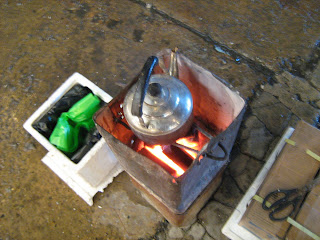In an attempt to blog properly (i.e. not writing about things six weeks after they happen), I'm writing this from a Pomato restaurant down the street from the Noryangjin Fisheries Wholesale Market. Pomato is one of several chains of small diners that offer tasty Korean food at very reasonable prices. I'm having doenjang jigae, a spicy kimchi and soybean broth with seafood and tofu. It comes with rice, kimchi, delicious crispy yellow stuff and three side dishes and costs 3,500 won (NZ$4.50). One of us will have to write about these places properly some time.

Just like a real blogger!
From the number nine subway the market is down the road and through a tunnel that goes under the (street level) number one line train tracks. The tunnel is full of ajummas selling everything from dried beans and fish to shoes and clothing. They all have metal buckets with charcoal briquettes burning to keep them warm. Through the tunnel are a few market buildings and some stalls selling the usual range of street stuff.

Past this is the market itself, a huge shed-like building, really just a big roof about three stories high. There is a deccent size market in Buan, but it would only take up a small corner of Noryangjin. The place is lined with rows and rows of vendors selling a range of different fish, many of them specialising: some selling just fish, some shellfish, some mystery seafood. One stall sold only prawns and had every size from just bigger than a shrimp to huge things seven or eight inches long. I'd heard that they sometimes have huge whole tuna, but there was none of that today, although they did have some pieces that obviuosly came from a very big fish.

One of the most interesting was the row of (mostly) women selling sliced raw fish. This is a Korean delicacy for which Busan is famous. Some of the women are incredibly skillful, cutting perfect slices super fast. I tried to take a video but my techno-mongolism made me stuff it up.
I wanted to get some salmon but I asked on of the vendors and he wanted 20,000 won for a medium sized piece, which seemed pretty high especially since I didn't know what I'd be paying to have it cooked.
After looking around the market I went upstairs to the restaurant area. There were only a few restaurants and none of them had prices up, and it wasn't clear which of them had a cooking service or what it would cost, so I left that for another time and went to Pomato. We did a simillar thing in the Philippines which I'll write about in my Philippines post. I'll do some research and go to Noryangjin again once I know more about it
Part Two
In keeping with my new timely blogging kick, I'm writing this from the subway. I went to Incheon to explore the Chinatown there and get in the mood for China next week, and now I have a long ride (thirty stations of the blue line) back to Jongno where Anna's sussing out a motel. She's been at Lotte World all day with a secret accomplice who is supposed to be working.
I did the Chinatown walk in our Lonely Planet book, which starts from Incheon Station. The first stop was the First Paeru, a big Chinese-style gate at the base of a hill opposite the station. I continued up the hill lined with shops decorated with red paper lanterns and selling all manner of tacky Chinese souvenirs. Next was a staircase with some interesting paintings on and next to it, and the Third Paeru at the top.
Further on was a pavilion with some great views over Incheon. This wasn't in the Lonely Planet walk which surprised me a bit, since it was just off the main path and really worthwhile. It also had some interesting graffiti above the stairs.


After that it was the memorial to the centenary of U.S.-Korea relations, an amazing structure made up of huge triangles shooting up into the air and almost, but not quite, meeting at the top. It made for some cool photos so I stayed a while before heading to the statue of General MacArthur.

Next it was back down the other side of the hill to the completely unimpressive Jung-gu District Hall, a building that Lonely Planet and the Incheon City Council think is worth visiting because it was built by the Japanese in 1925. In lieu of a photo, imagine any public administration building built in the 1920s. It looks like that.
The area around Chinatown was interesting though, traditional Chinese and Korean buildings jostling for room with slick modern clothes shops and seedy looking bars. Such is the variety of this fascinating mess that I walked right past Bboya, a cafe completely covered in mosaics made from bottle caps. I went back when I realised I'd missed it and I'm glad I did, the mosaics were amazing. Unfortunately it was closed so I'll have to go back to see the inside, which is apparently covered in even more mosaics. On the next street were some interesting old buildings which originally held Japanese banks when they were built in the 1890s.
Next I went up a long tall staircase with stone lanterns lining the sides and an impressive statue of Confucious at the top. The light was fading badly by this stage so I couldn't get any good photos. Then it was down the hill past a cool mural of historical scenes and back to the main Chinatown area. I had dinner at a Chinese restaurant, delicious fried dumplings and disappointing noodles. I walked back down the lantern lined hill and got on the subway back to Seoul.

















No comments:
Post a Comment